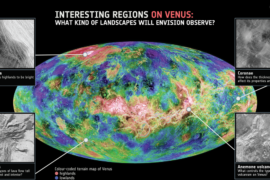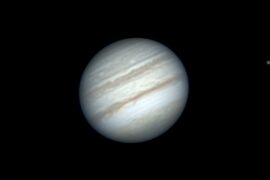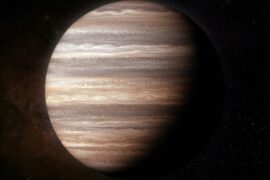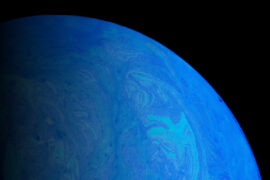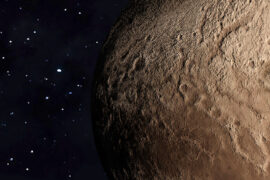If you could just look at Venus and Jupiter from afar at the same time, you might think they’d have a lot in common. They look kind of similar to each other as the clouds in their atmospheres share some colors.
But in reality, Venus and Jupiter are two of the most different planets in the Solar system. Their size, composition, and even rotation are at opposite extremes when you compare them.
And yet, all of the planets in the Solar system do have certain things in common as they share a parallel origin story.
In this article, we’ll compare Venus and Jupiter and take a look at their differences and similarities to learn more about these two very important pieces of the Solar system.
Venus vs Jupiter comparison
The table below shows a quick comparison of Venus and Jupiter by the numbers.
| Venus | Jupiter | |
|---|---|---|
| Position in the Solar system | 2 | 5 |
| Distance from the Sun (avg) | 108 million km | 741 million km |
| Radius | 6,051 km | 69,900 km |
| Mass | 4.8675×1024 kg | 1.9 × 1027 kg |
| Rotation period (1 day) | 243 days | 10 hours |
| Rotation speed | 6.52 km/h | 45,000 km/h |
| Orbit period (1 year) | 224.7 days | 11.85 years |
| Orbital speed | 35.02 km/s | 13.07 km/s |
| Surface temperature (avg) | 464 °C | −110 °C |
| Surface pressure | 9,300 kPa | 200 – 600 kPa |
| Surface gravity | 8.9 m/s2 | 24.79 m/s2 |
| Density | 5.24 g/cm3 | 1.33 g/cm3 |
| Escape Velocity | 10.36 km/s | 59.5 km/s |
| Albedo | 0.689 | 0.5 |
| Satellites (Moons) | 0 | 95 |
| Core | rock | rock, metal, ice |
| Atmosphere | 96.5% CO2, 3.5% N | 89% H, 10% He, 0.3% CH4, traces of others |
Venus and Jupiter size comparison
The most obvious difference between Jupiter and Venus is their size. Although that is true for pretty much every planet that you want to compare to Jupiter.
Jupiter is by far the biggest planet in the Solar system. It has a diameter of 139,800 kilometers (86,867 miles). That is almost 12 times the diameter of Venus which is only 12,102 kilometers (7,520 miles). For comparison, Venus is almost the same size as Earth.
This all means that in volume, you could fit about 1,350 planets the size of Venus in just one Jupiter.
The following image shows the large size difference between Venus and Jupiter.
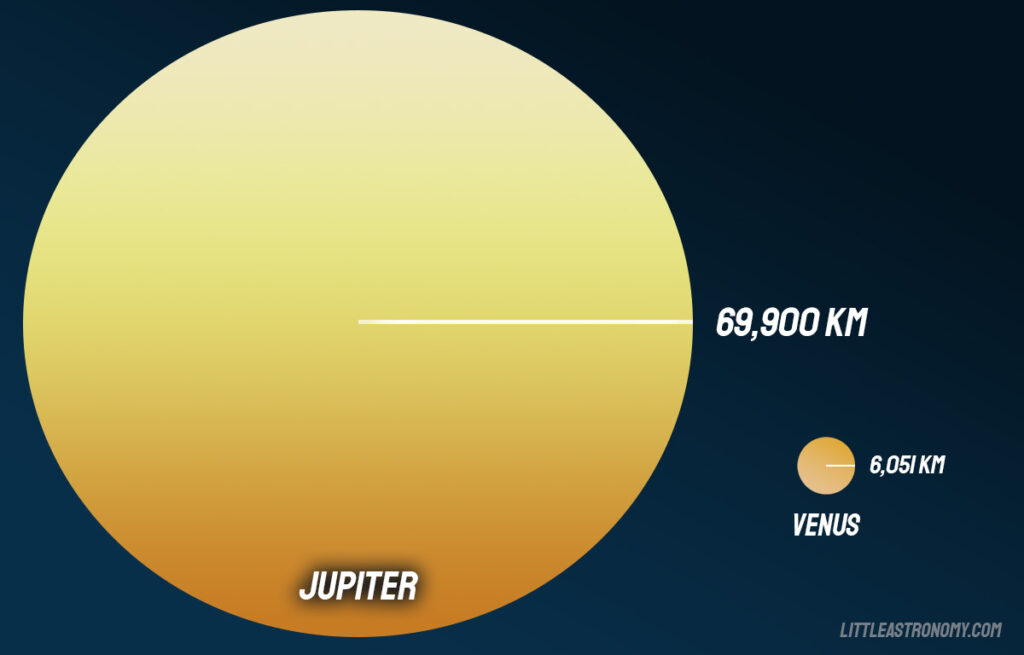
Venus and Jupiter similarities
- Both planets orbit the Sun
- Venus and Jupiter have the same age. They both formed around 4.6 billion years ago.
- Both planets formed out of the same proto-planetary disc, a cloud of dust and gas that swirled around the Sun after it was formed.
- Both planets have achieved “hydrostatic equilibrium”, which is a fancy term to say their gravity has shaped them like a sphere.
- Both planets have cleared their orbits of every other large object.
- The clouds of both planets share many colors. Light yellow, orange, and white.
- They are two of the most reflective planets in the Solar system.
- Both planets were known to ancient civilizations. We don’t know who discovered them or named them.
- Both planets are visible from Earth without help from a telescope.
- Both planets have atmospheres.
- Both planets have extreme weather, including electrical storms and strong winds.
- Venus and Jupiter both have magnetic fields and magnetospheres.
- Both planets are named after Roman mythological gods. Venus is named after the goddess of beauty, and Jupiter after the god of thunder.
- Both planets are located outside the habitable zone of the Solar system. Neither planet has oceans or continents.
Venus and Jupiter differences
- The most obvious difference between Jupiter and Venus is their size. Jupiter is the largest planet in the Solar system, Venus is the third smallest. You could fit about 1,350 Venus-sized planets in Jupiter.
- Jupiter is the planet that rotates the fastest in the Solar system. Venus has the slowest rotation. Despite its large size, Jupiter completes one rotation in just 10 hours.
- Venus and Jupiter rotate in different directions. Venus rotates clockwise and Jupiter counter-clockwise. Venus and Uranus are the only planets in the Solar system that don’t rotate counter-clockwise.
- Venus is a rocky planet with a solid surface. Jupiter is made out of gas and does not have a surface. If a ship were to fall into Jupiter, it would just free-fall into its core (assuming it could survive the extreme wind, pressure, and temperature).
- Speaking of temperature, Venus is the hottest planet in the Solar system. Its average temperature is 464°C (867°F). Jupiter is very cold with average temperatures of -110°C (-166°F).
- The cores of both planets are very different in size and composition. Scientists aren’t even certain yet as to whether Jupiter has a solid core or not.
- Venus is one of only two planets in the Solar system that have no natural satellites (moons). Jupiter has many of them. The latest count is 95 moons.
- Jupiter has rings like Saturn, they are just much thinner and less visible. Venus doesn’t have any rings.
- Venus is one of the most dense planets in the Solar system. Since Jupiter is made out of gas, it is the second least dense planet only above Saturn.
- Venus travels through space almost 3 times as fast as Jupiter. This is why it takes Jupiter almost 12 Earth years to complete a single orbit around the Sun.
- Jupiter is almost 7 times farther away from the Sun than Venus.
Summary
- Venus and Jupiter are very different planets.
- The similarities between Venus and Jupiter include their age, reflectiveness, ferocious weather, and the color of some of their clouds,
- The differences between Venus and Jupiter include their vastly different sizes, rotation speed, rotation direction, number of satellites, and temperatures, amongst many others.
Enjoyed this article?
Get daily 10-minute PDFs about astronomy to read before bed!
Sign up for our upcoming micro-learning service where you will learn something new about space and beyond every day while winding down.


